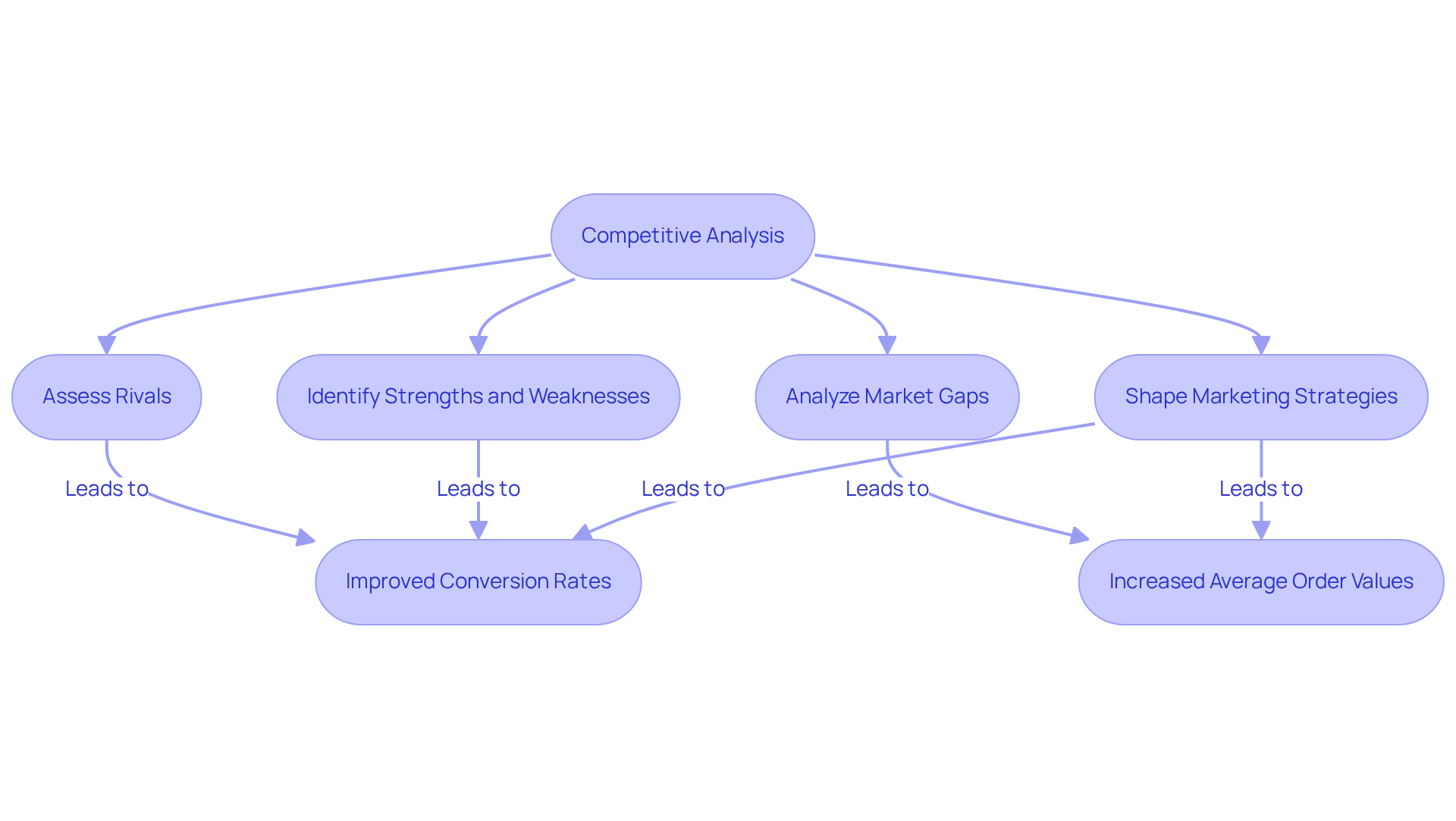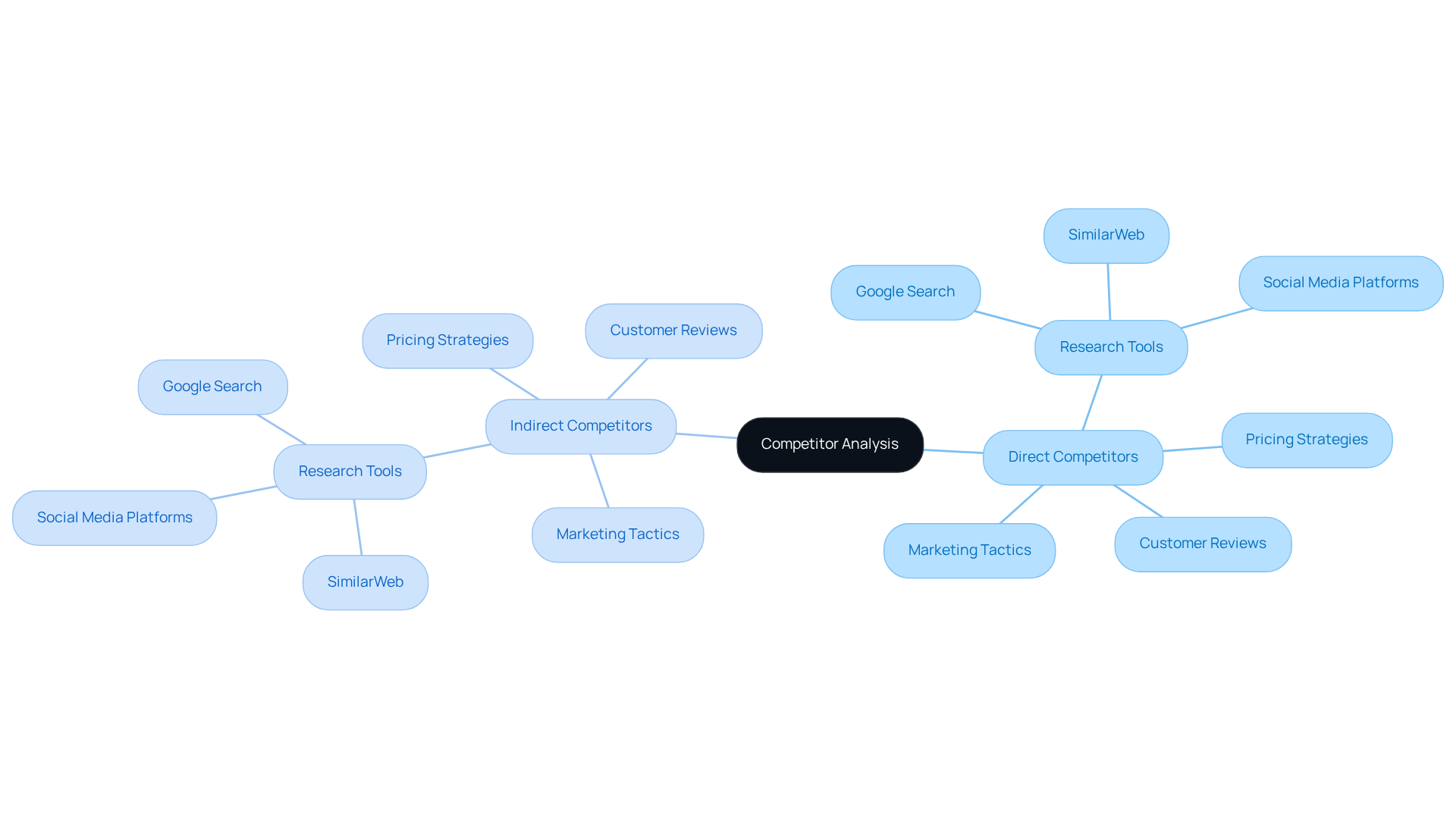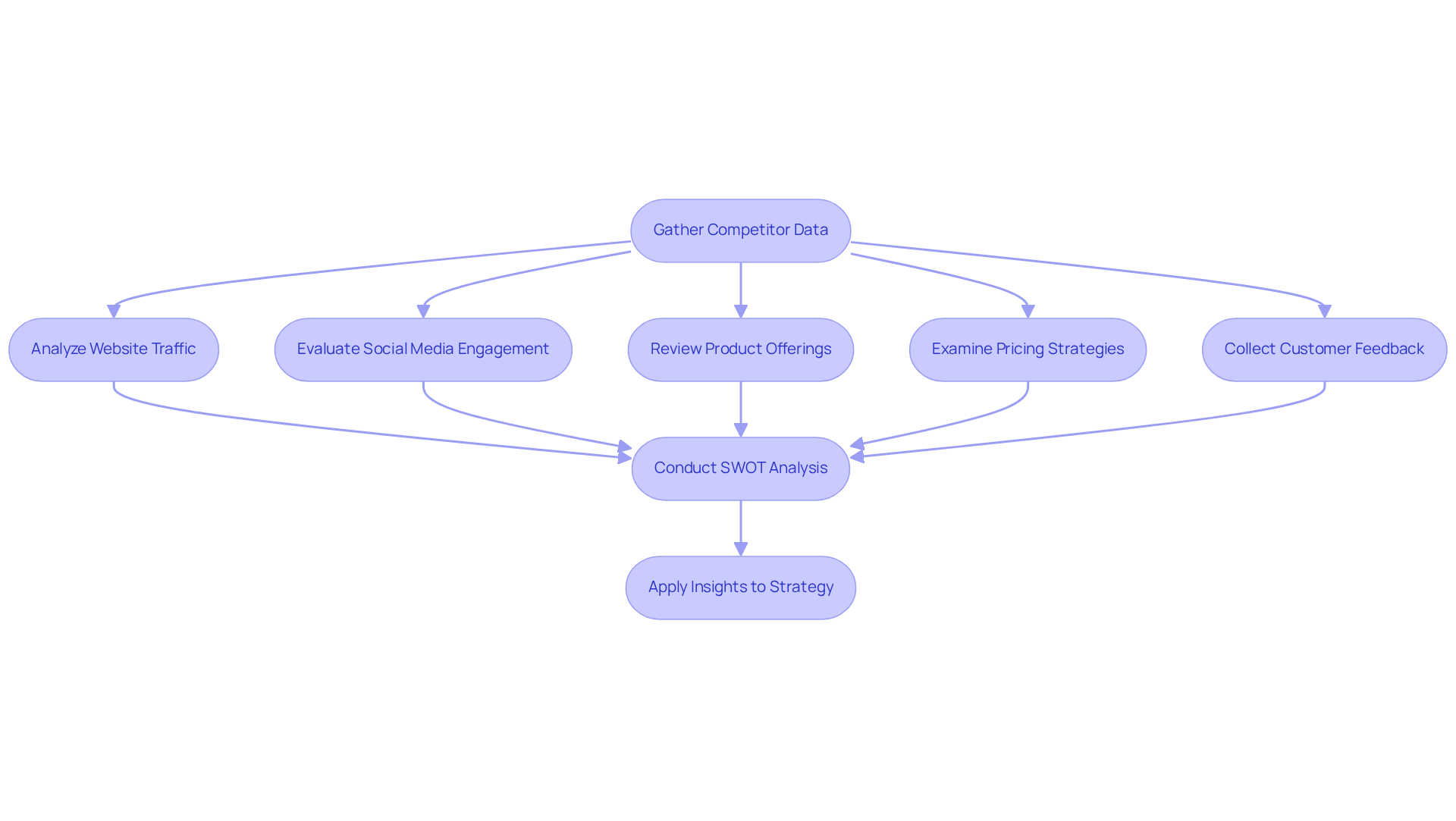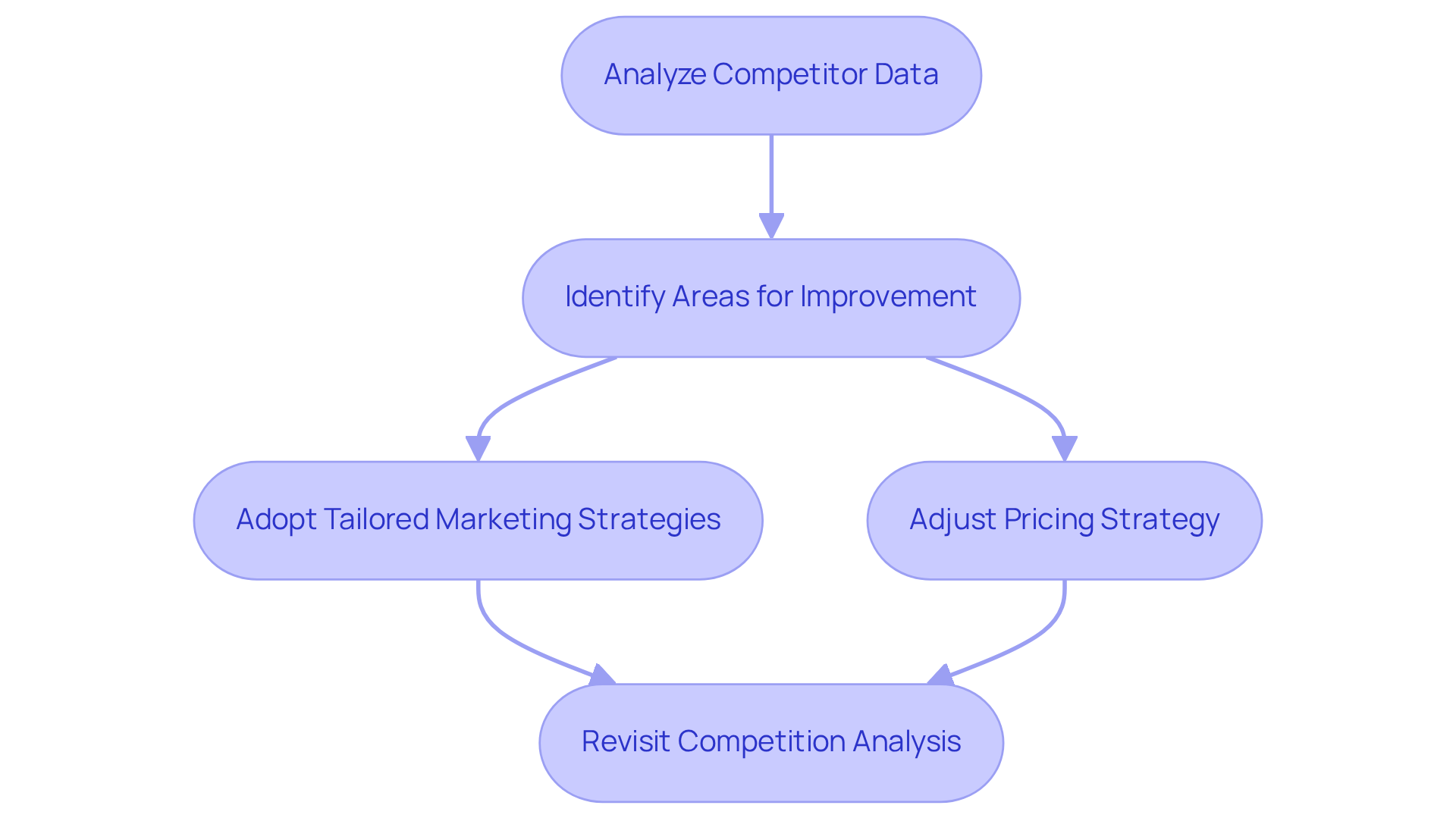
Overview
The article delineates a four-step process for conducting effective competition analysis, underscoring its critical role for companies aiming to comprehend their rivals' strengths and weaknesses to bolster their market position. This assertion is supported by compelling examples of successful strategies employed by industry leaders such as Parah Group and Coty. These case studies illustrate how data-driven insights can significantly enhance conversion rates, elevate average order values, and refine brand strategies. By leveraging these insights, businesses can strategically position themselves in a competitive landscape, driving both growth and profitability.
Introduction
Understanding the competitive landscape stands as a cornerstone for any business aiming for success, especially in today's swiftly changing market. A comprehensive competitive analysis reveals invaluable insights into rivals' strengths and weaknesses, empowering companies to pinpoint market opportunities and fine-tune their strategies. Yet, the pressing question persists: how can businesses efficiently gather and analyze this critical information to not only keep pace with competitors but also establish a distinctive position in the marketplace? This article delineates four essential steps for conducting effective competition analysis, equipping brands with the necessary tools to optimize their strategies and drive growth.
Define Competitive Analysis and Its Importance
A competition analysis example is a critical process that involves assessing your rivals to understand their strengths, weaknesses, strategies, and market positions. This analysis is essential for companies, as it helps identify market gaps, informs product development, and shapes marketing strategies. By comprehensively understanding what competitors excel at and where they falter, companies can position themselves more effectively and seize opportunities to enhance profitability. For direct-to-consumer (DTC) companies, this insight is particularly vital in a landscape characterized by rising customer acquisition costs and fierce competition. A well-executed competitive analysis can lead to improved conversion rates and increased average order values (AOV).
For instance, Parah Group has effectively harnessed competitive analysis to boost the profitability of several DTC companies through innovative conversion rate optimization (CRO) strategies. In one notable case:
- A $30 million clothing line experienced a remarkable 35% increase in conversion rates and a 10% rise in revenue per visitor after launching a redesigned homepage that emphasized social proof and optimized pricing.
- A $15 million cleaning product brand enhanced its AOV by 80% by testing free shipping thresholds and introducing bundled offers to encourage larger purchases.
These transformational case studies underscore the significance of understanding competitive dynamics and leveraging proven strategies derived from thorough competition analysis example to drive revenue growth and enhance profitability.

Identify Your Competitors and Their Market Position
To effectively recognize your rivals, it is essential to classify them into direct and indirect challengers. Direct rivals offer comparable products or services to the same target audience, while indirect rivals fulfill similar customer needs through alternative methods.
Utilize tools such as Google Search, SimilarWeb, and social media platforms to gather comprehensive information about these competitors. Furthermore, analyze their market positioning by examining their pricing strategies, customer reviews, and marketing tactics.
This competition analysis example will provide insight into where your brand stands in relation to others and will highlight areas for improvement. For instance, if a competitor is gaining traction with a specific demographic, consider how you can adapt your offerings to better meet that audience's needs.

Gather and Analyze Competitor Data
Recognizing your rivals is just the beginning; the next critical step is to perform a competition analysis example to gather comprehensive information on their operations. This involves conducting a competition analysis example that includes a thorough analysis of their website traffic, social media engagement, product offerings, pricing strategies, and customer feedback. Tools like SEMrush and Ahrefs provide invaluable insights into rivals' online performance, revealing essential metrics such as organic search traffic and keyword rankings. Additionally, social media analytics platforms offer engagement statistics that highlight how rivals connect with their audience.
Conducting a competition analysis example through a SWOT analysis (Strengths, Weaknesses, Opportunities, Threats) for each competitor is vital for summarizing your findings in a structured format. This method allows you to identify areas where rivals excel and where they may fall short. For example, a competition analysis example may reveal that if a competitor boasts a robust social media presence yet struggles with customer service, this gap presents a significant opportunity for your brand to stand out by enhancing customer support.
Brands like Coty have successfully integrated consumer insights into their competitive assessments, shifting from assumptions to evidence-based strategies. As Nithya Seshachalam, Strategy & Insights Lead at Coty, remarked, "With Revuze, we’ve moved from assumptions to evidence. The data shows us not just what’s trending, but why and what to do about it." Coty has refined its offerings and marketing strategies as a competition analysis example by leveraging tools such as Revuze, which provides unfiltered Voice of Customer (VoC) data to align more closely with consumer expectations. This data-driven approach not only directs product development but also enhances overall market agility, allowing companies to swiftly adapt to emerging trends and shifts in consumer sentiment. Furthermore, Coty's capacity to pinpoint legacy products requiring updates based on consumer expectations exemplifies the practical application of the analysis discussed.

Apply Insights to Optimize Your Brand Strategy
Leveraging insights from competitor data serves as a valuable competition analysis example that is crucial for refining your brand strategy. Begin by pinpointing specific areas for improvement, drawing on the strengths and weaknesses of your competitors. For instance, if competitors are effectively using tailored marketing strategies, consider adopting similar approaches to boost customer engagement.
Research shows that direct-to-consumer (DTC) companies employing personalized marketing experience substantial increases in customer loyalty and conversion rates. Furthermore, if competitors are pricing similar products lower, it may be necessary to adjust your pricing strategy to remain competitive.
Regularly revisiting your competition analysis example is vital to stay aligned with market dynamics and shifting consumer preferences. By consistently refining your strategies based on these insights, you can fortify your brand's market position and promote sustainable growth.

Conclusion
Understanding the competitive landscape is essential for any business aiming to thrive in a crowded market. Effective competition analysis not only reveals the strengths and weaknesses of rivals but also uncovers opportunities that can be leveraged for growth. By systematically evaluating competitors, companies can refine their strategies, enhance their offerings, and ultimately improve their market position.
This article presents a comprehensive four-step approach to conducting effective competition analysis. It emphasizes the importance of:
- Identifying both direct and indirect competitors
- Gathering and analyzing relevant data
- Applying insights to optimize brand strategies
Noteworthy examples from successful companies like Parah Group and Coty illustrate how informed decisions based on competitive insights can lead to significant improvements in conversion rates and overall profitability.
In an ever-evolving business environment, the ability to adapt and respond to competitive dynamics is crucial. Companies are encouraged to continuously revisit their competitive analysis to stay attuned to market shifts and consumer preferences. By embracing this proactive approach, businesses can not only enhance their strategic positioning but also foster sustainable growth in a challenging marketplace.
Frequently Asked Questions
What is competitive analysis?
Competitive analysis is the process of assessing your rivals to understand their strengths, weaknesses, strategies, and market positions.
Why is competitive analysis important for companies?
Competitive analysis is essential for companies as it helps identify market gaps, informs product development, and shapes marketing strategies. It allows companies to understand competitors' strengths and weaknesses, enabling them to position themselves effectively and seize opportunities for increased profitability.
How does competitive analysis benefit direct-to-consumer (DTC) companies?
For DTC companies, competitive analysis is vital in a landscape with rising customer acquisition costs and fierce competition. It can lead to improved conversion rates and increased average order values (AOV).
Can you provide an example of successful competitive analysis?
Yes, one example is the Parah Group, which used competitive analysis to enhance the profitability of DTC companies. A $30 million clothing line saw a 35% increase in conversion rates and a 10% rise in revenue per visitor after redesigning its homepage to emphasize social proof and optimize pricing. Additionally, a $15 million cleaning product brand increased its AOV by 80% by testing free shipping thresholds and introducing bundled offers.
What are the outcomes of effective competitive analysis?
Effective competitive analysis can lead to improved conversion rates, increased average order values, and overall revenue growth by leveraging insights gained from understanding competitive dynamics and implementing proven strategies.
FAQs











